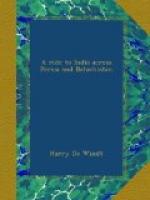Mark Tapley himself would scarcely have taken a cheerful view of things on landing at Sonmiani. Imagine a howling wilderness of rock and scrub, stretching away to where, on the far horizon, some low hills cut the brazen sky-line. On the beach the so-called town of Sonmiani—a collection of dilapidated mud huts, over which two or three tattered red and yellow banners flutter in the breeze, and beneath which a small and shallow harbour emits a powerful odour of mud, sewage, and rotten fish. Every hut is surmounted by a “badgir,” or wind-catcher—a queer-looking contrivance, in shape exactly like a prompter’s box, used in the summer heats to cool the interior of the dark, stifling huts. A mob of ragged, wild-looking Baluchis, with long, matted locks and gaudy rags, completes this dreary picture.
Shouts of “Kamoo!” from the crowd brought a tall, good-looking native, clad in white, out of an adjacent hut, who, I was relieved to find, was the interpreter destined to accompany us to Kelat. The camels and escort were, he said, ready for a start on the morrow, if necessary. In the mean time there was a bare but clean Government bungalow at our disposal, and in this we were soon settled. But notwithstanding the comparative comfort of our quarters compared with the filthy native houses around, I determined to get away as soon as possible. The mosquitoes were bad enough, but the flies were far worse. Ceiling, walls, and floor were black with them. One not only ate them with one’s food, but they inflicted a nasty, poisonous bite. As for the smells, they were beyond description; but the fact that a dead camel was slowly decomposing in the immediate vicinity of our dwelling may have had something to do with this.
With all these drawbacks, I was glad to find the population, although dirty, decidedly friendly—rather too much so, indeed; for the little whitewashed room was crowded to overflowing the greater part of the day with relays of visitors, who apparently looked upon us as a kind of show got up for their entertainment. Towards sunset a tall, swarthy fellow, about fifty years old, with sharp, restless eyes and a huge hook nose, made his appearance at the doorway; and this was the signal for a general stampede, for my visitor was no other than the head-man of Sonmiani—Chengiz Khan.
Chengiz was attired in a very dirty white garment, loose and flowing to the heels, and a pair of gold-embroidered slippers. A small conical cap of green silk was perched rakishly on the top of his head, from which fell, below the shoulders, a tumbled mass of thick, coarse, black hair. The head-man was unarmed, but his followers, five in number, fairly bristled with daggers and pistols. Like all natives, Chengiz was at first shy and reserved. It was only when I had prevailed upon him to take a cigar that my visitor became more at his ease. Having lit his cheroot, he took a long pull and passed it on to one of his followers, who repeated the performance. When it had gone the round twice it was thrown away; and Chengiz, turning to Kamoo, gravely asked if I wished for anything before he retired for the night.




